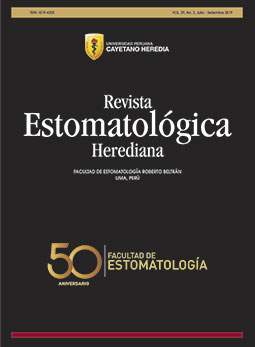Ridge preservation in posterior sites: A systematic review
DOI:
https://doi.org/10.20453/reh.v29i3.3605Keywords:
Dental implants; tooth extraction; molar; alveolar process; bone resorption; systematic review.Abstract
Objective: To evaluate the dimensional changes produced after a dental extraction in the posterior sites using techniques of preservation of ridge and conventional healing. Materials and methods: Two independent and calibrated reviewers conducted an electronic search of randomized clinical trials published until December 2018 in Pubmed and Cochrane, which was complemented by a manual search in the journals with the greatest impact in Periodontics and Implantology according to the ISI Web of Science. The evaluation of the risk of bias in the included studies was carried out following the Cochrane manual for interventions of systematic reviews Version 5.1.0. Results: A total of 435 posterior pieces, between premolars and molars, were evaluated in the included studies after 3 months post extraction. Statistically significant values were obtained for the group that performed ridge preservation (vertical bone loss from -0.25 to -1.53 mm and horizontally from -0.91 to -2.87 mm) compared to the control group (vertical bone loss from -0.71 to -3.1 mm and at horizontal level from -2.26 to -3.96 mm). The most used biomaterial was the xenograft plus collagen membrane. The included studies showed a low risk of bias. Conclusions: The ridge preservation in posterior sites leads to: maintaining hard and soft tissues, reduces sinus pneumatization and minimizes the resorption of the crestal bone, generating a great volume of bone tissue, thus simplifying the procedures for a good three-dimensional position of the implant.
Downloads
Downloads
Published
How to Cite
Issue
Section
License
The authors retain the copyright and cede to the journal the right of first publication, with the work registered with the Creative Commons License, which allows third parties to use what is published as long as they mention the authorship of the work, and to the first publication in this journal.























